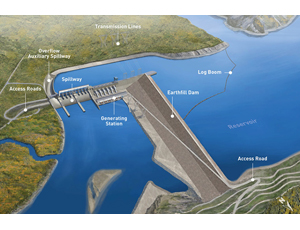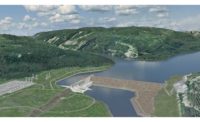

BC Hydro engineers are disputing accusations that a proposed CA$7.9-billion ($7.2 billion) dam in northeastern British Columbia will damage wildlife migratory routes and trample on First Nation aboriginal rights. At public hearings in December and January, BC Hydro submitted more than 27,000 documents to assure stakeholders the Site C Dam would be safe, clean and sensitive to aboriginal rights.
“We have very good mitigation plans proposed,” says John Nunn, BC Hydro senior project engineer. “And we’re trying to negotiate impact-benefit agreements with various First Nations so that their interests and needs will be accommodated, as well.”
Interest in the Site C Dam skyrocketed in 2010, when BC Hydro's provincial government announced it was ending a 20-year moratorium on the development of the controversial dam. Since then, the on-again, off-again project has run a gauntlet of criticism from environmentalists, First Nations and property owners concerned about potential flooding and damage to aboriginal gravesites.
Nunn is quick to dispute the argument that development could result in floods and erosion from blocked or accelerated river flows similar to those that occurred at the nearby W.A.C. Bennett Dam, built in 1967. An environmental engineer’s study, released in December, disproved those claims, Nunn says. “The engineer was able to reconstruct the cyclical changes of flow in the delta and, basically, could find no evidence in that record of any changes post-Bennett,” he says. Site C, Nunn concludes, should remain unscathed, too.
Further, the Site C Dam would rest on sedimentary rock across a much smaller footprint—1/20th the size of the Bennett dam’s upstream reservoir—and be built to “more robust” seismic standards. In addition, BC Hydro’s design includes an overflow auxiliary spillway “so that, in the unlikely event that none of the spillway gates work, the overflow spillway will allow us to pass 4,000 cubic meters of water per second.” The spillway also exceeds the probable maximum flood design, while the reservoir is designed for partial drawdown in the event of an earthquake.
Nunn says the driver behind the project is an expected 26% increase by 2023 of the provincial population, which now stands at 4.4 million. Over that same period, the power demand is expected to increase 40%; up to 78% of that, he adds, would be met through a “very aggressive, demand-side management program” to get more power out of existing facilities and encourage residents to conserve more energy. Site C should meet the remaining power demand with 1,100 MW of capacity and about 5,100 GW/h of energy.
Site C’s other benefits are economic, Nunn points out. “The projection is that the project would provide … a total of about 33,000 person-years [of work] through all stages of development and construction,” he says.
That figure includes spinoff jobs from support industries and consultant fees, adds Nunn’s colleague, engineering division manager Andrew Watson. He also agrees with Nunn’s assertion that the CA$7.9-billion price tag “is the lowest-cost energy option BC Hydro has in dollars per MW/h.” And while much of the engineering at Site C will be supplied by local firms, Watson says BC Hydro also is drawing on “a range of experts from around the planet,” notably in geotechnical and hydraulic engineering.
“I suppose that’s what happens when a project keeps getting deferred,” Watson laughs. “This project has had a tremendous amount of engineering on it, but I can’t think of a hydroelectric project which has delivered more benefits than Site C.”


Post a comment to this article
Report Abusive Comment